Apache Flink, versions 1.9.0 and later, support Python, thus creating PyFlink. In the latest version of Flink, 1.10, PyFlink provides support for Python user-defined functions, allowing you to register and use these functions in Table APIs and SQL.
Written as a quick guide to PyFlink, this article will answer these questions and provide a quick demo in which PyFlink is used to analyze Content Delivery Network (CDN) logs.
To implement PyFlink, we need to know the key objectives to be achieved and the core issues to be resolved. What are PyFlink's key objectives? In short, the key objectives of PyFlink are detailed as follows:
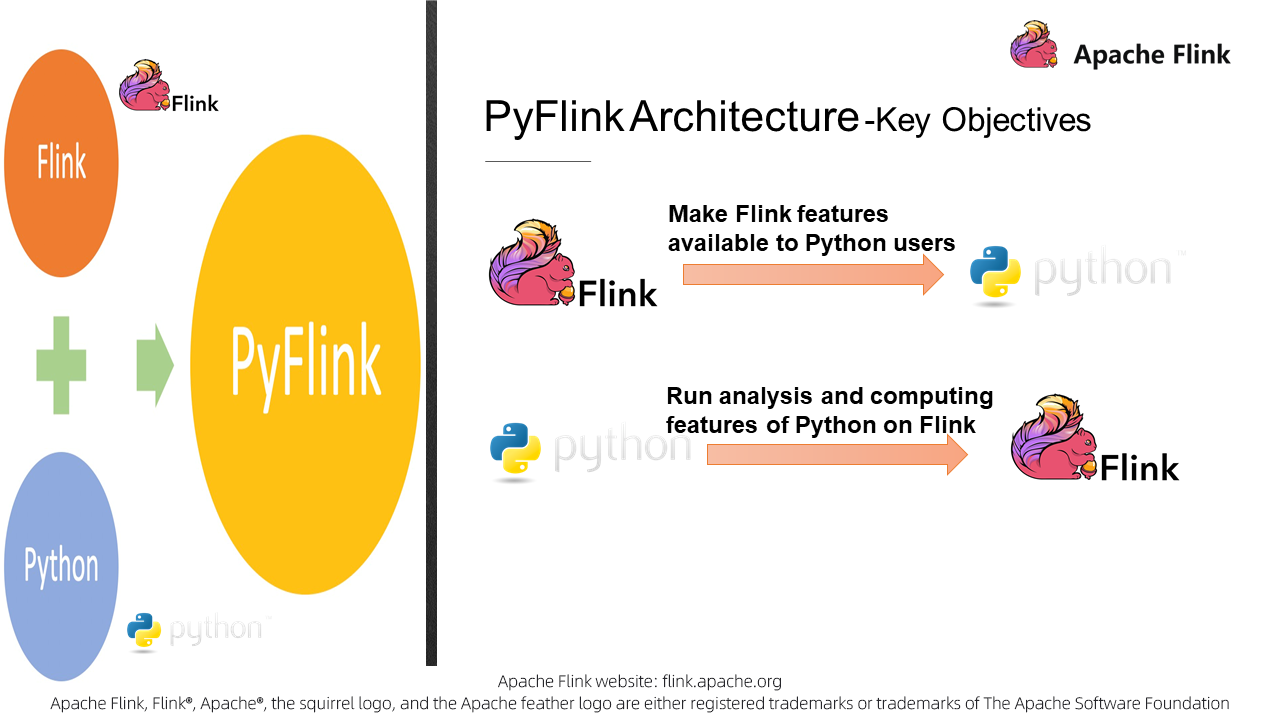
To implement PyFlink, do we need to develop a Python engine on Flink, like the existing Java engine? The answer is no. Attempts were made in Flink versions 1.8 and earlier, but they didn't work well. A basic design principle is to achieve given objectives at minimal costs. The simplest but best way is to provide one layer of Python APIs and reuse the existing computing engine.
Then, what Python APIs should we provide for Flink? They are familiar to us: the high-level Table API and SQL, and the stateful DataStream API. We are now getting closer to Flink's internal logic, and the next step is to provide a Table API and a DataStream API for Python. But, what exactly is the key issue left to be resolved then?
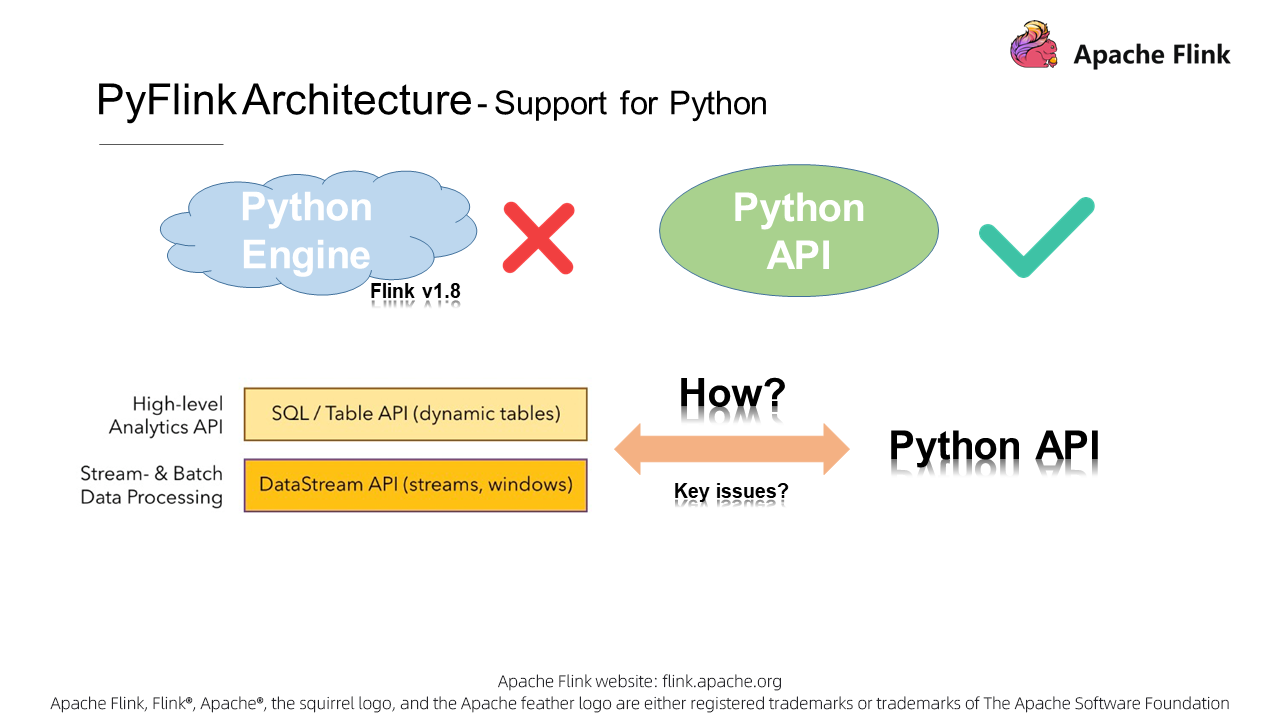
The Key Issue
Obviously, the key issue is to establish a handshake between a Python virtual machine (PyVM) and a Java virtual machine (JVM), which is essential for Flink to support multiple languages. To resolve this issue, we must select an appropriate communications technology. So, here we go.
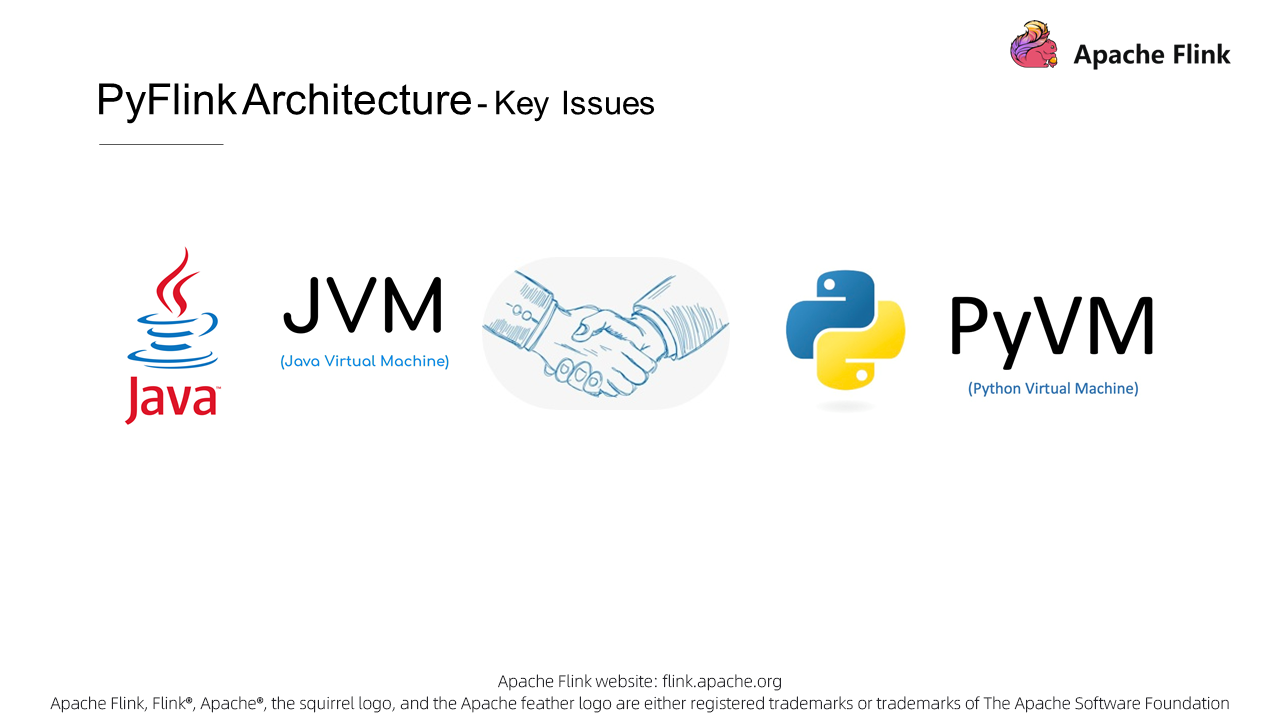
Selecting a Technology for Virtual Machine Communications
Currently, two solutions are available for implementing communications between PyVMs and JVMs, which are Apache Beam and Py4J. The former is a well-known project with multi-language and multi-engine support, and the latter is a dedicated solution for communication between PyVM and JVM. We can compare and contrast Apache Beam and Py4J from a few different perspectives to understand how they differ. First, consider this analogy: To get past a wall, Py4J would dig a hole in it like a mole, while Apache Beam would tear down the entire wall like a big bear . From this perspective, using Apache Beam to implement VM communication is somewhat complicated. In short, this is because Apache Beam focuses on universality and lacks flexibility in extreme cases.
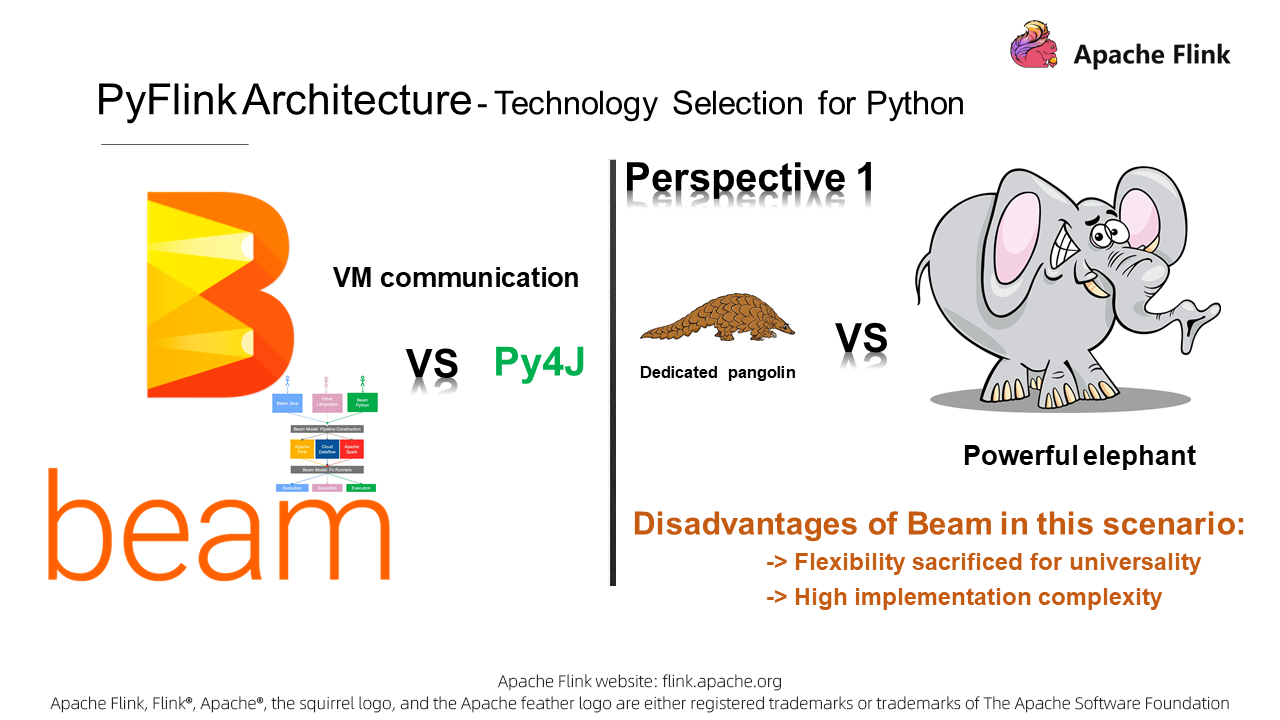
Besides this, Flink requires interactive programming like FLIP-36. Moreover, for Flink to work properly, we also need to ensure that there is semantic consistency in its API design, especially with regard to its multi-language support. The existing architecture of Apache Beam cannot meet these requirements, and so the answer is clear that Py4J is the best option for supporting communications between PyVMs and JVMs.
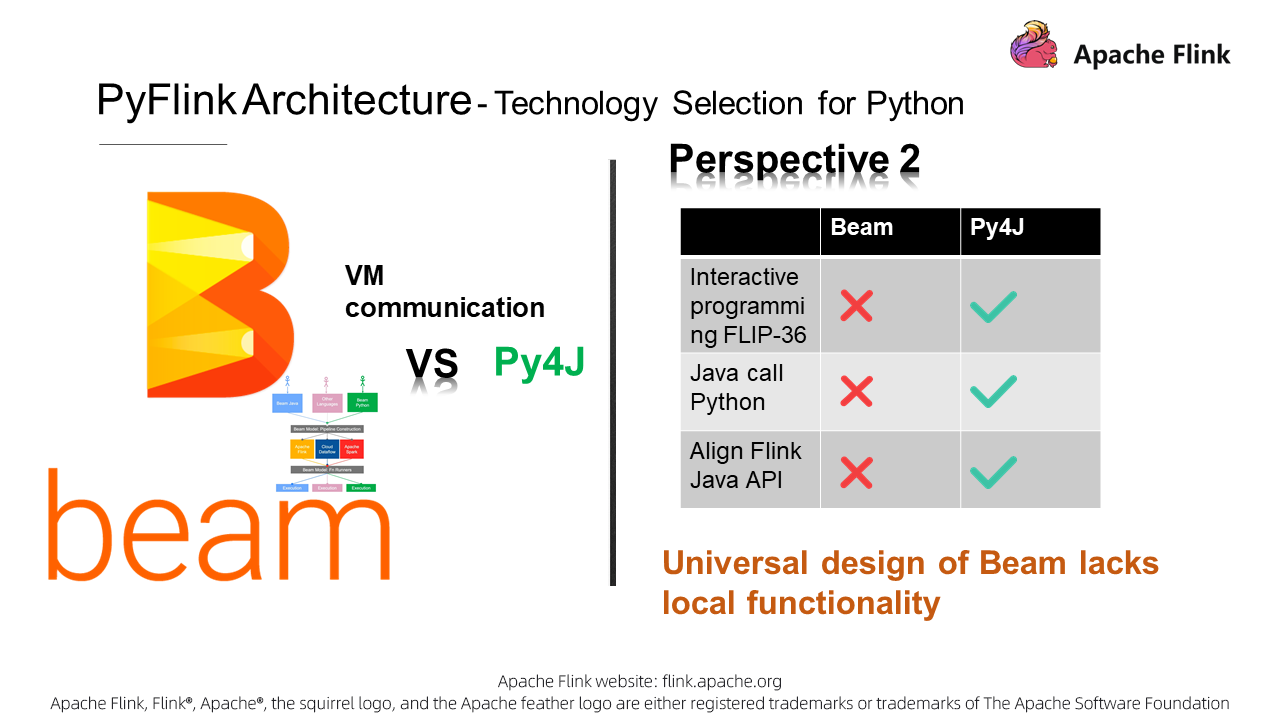
Technical Architecture
After establishing communications between a PyVM and JVM, we have achieved our first objective for making Flink features available to Python users. We achieved this already in Flink version 1.9. So, now, let's take a look at the architecture of the PyFlink API in Flink version 1.9:
Flink version 1.9 uses Py4J to implement virtual machine communications. We enabled a gateway for the PyVM, and a gateway server for the JVM to receive Python requests. In addition, we also provided objects such as TableENV and Table in the Python API, which are the same as those provided in the Java API. Therefore, the essence of writing the Python API is about how to call the Java API. Flink version 1.9 also resolved the issue of job deployment. It enables you to submit jobs through various ways, such as running Python commands and using the Python shell and CLI.
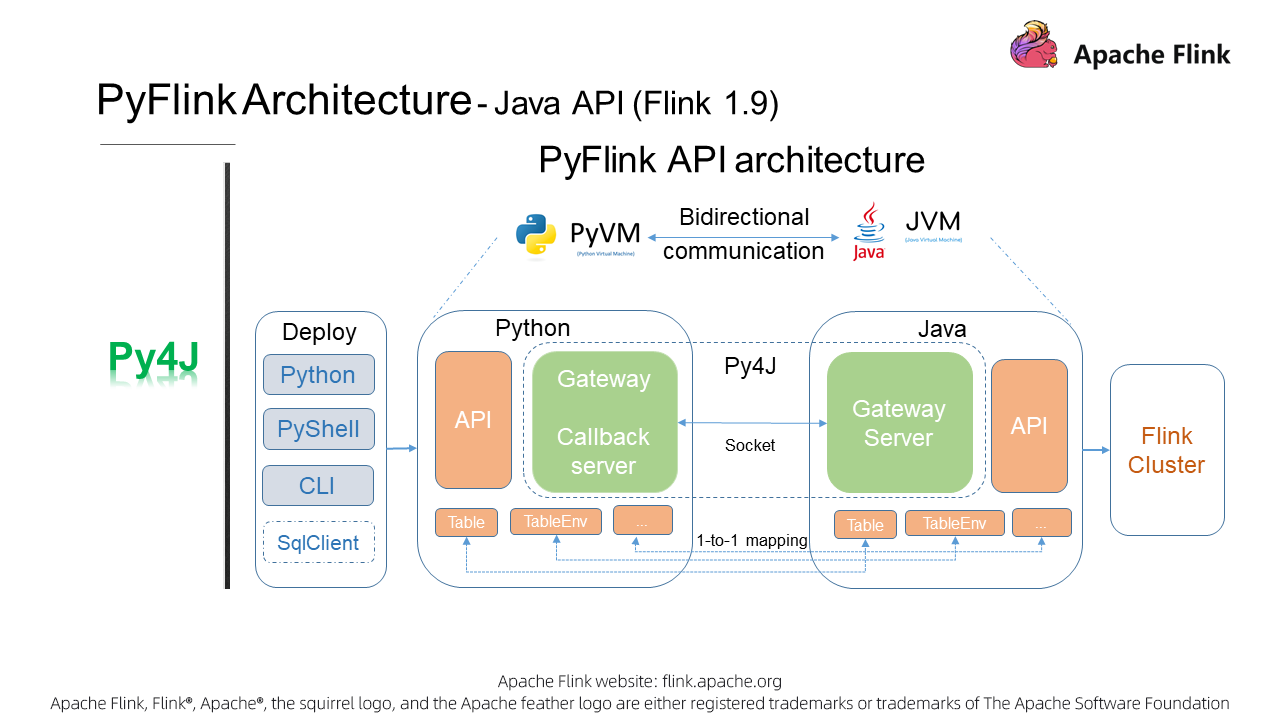
But, what advantages does this architecture provide? First, the architecture is simple, and ensures semantic consistency between the Python API and Java API. Second, it also provides superb Python job handling performance comparable to that of Java jobs. For example, the Flink Java API was able to process 2.551 billion data records per second during Double 11.
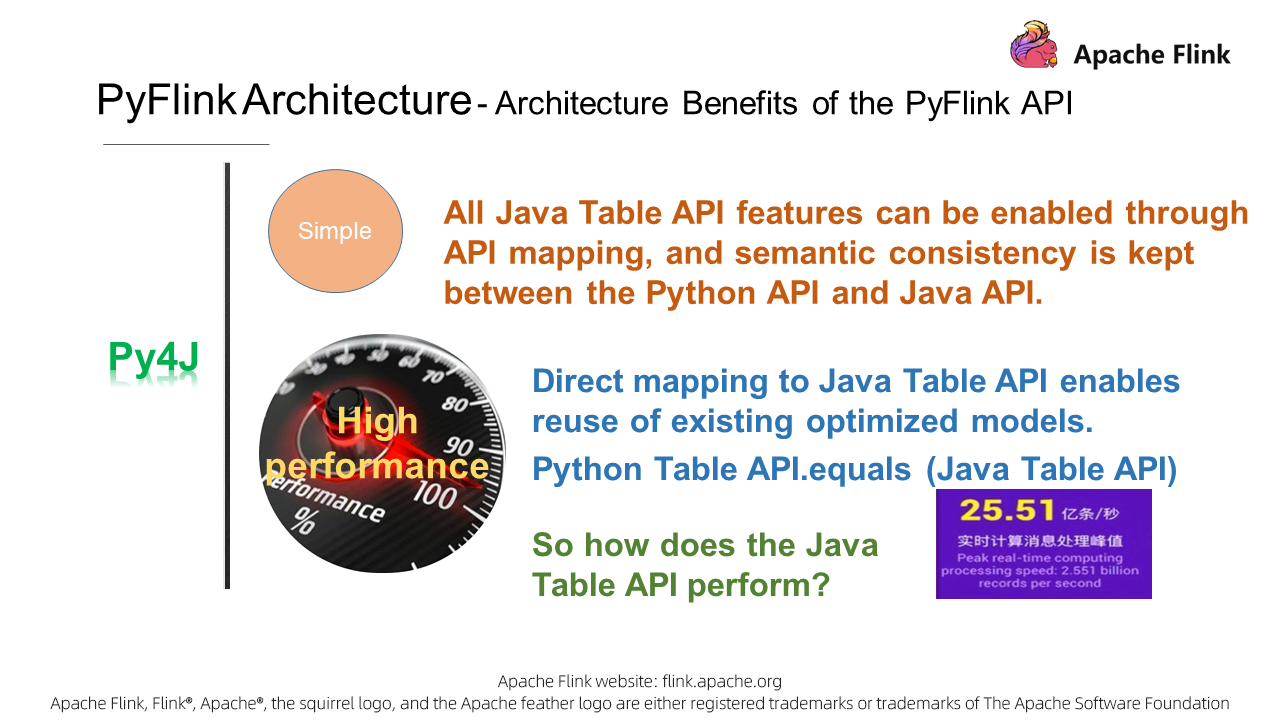
The previous section describes how to make Flink features available to Python users. This section shows you how to run Python functions on Flink. Generally, we can run Python functions on Flink in one of two ways:
Next, let's select a technology for this key issue.
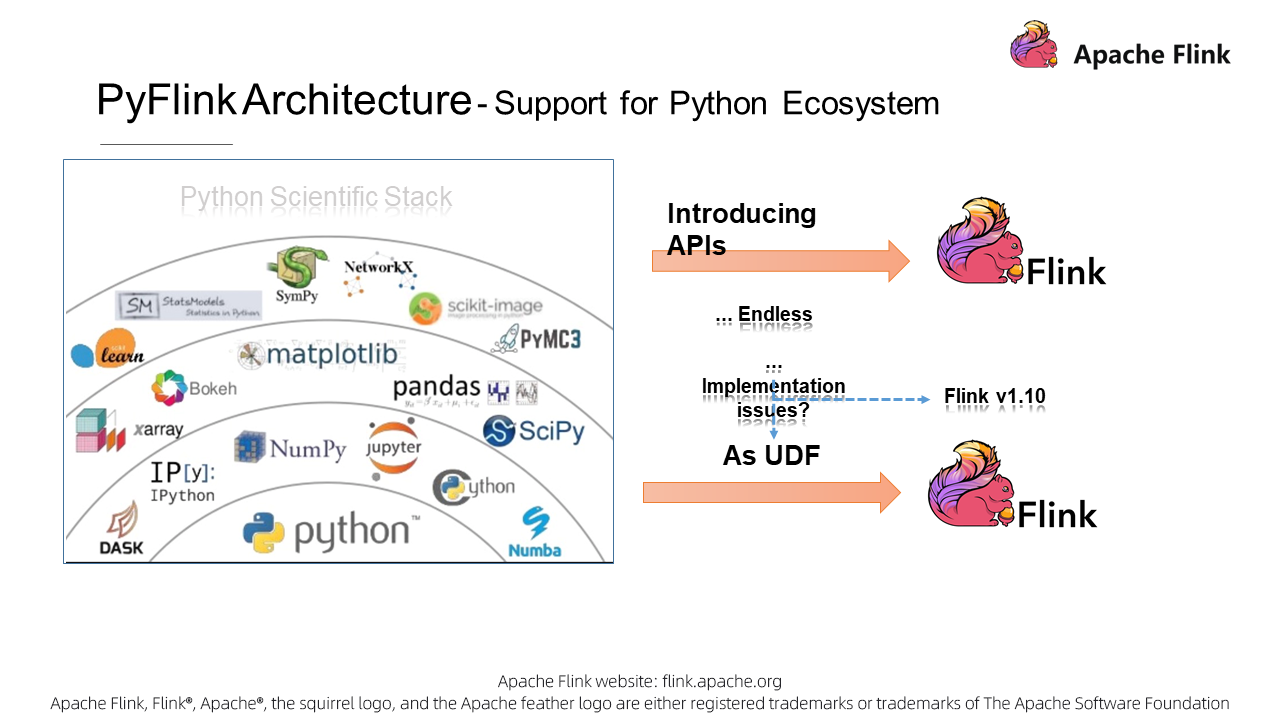
Selecting the Technology for Executing User-Defined Functions
Executing Python user-defined functions is actually quite complex. It involves not only communication between virtual machines, but also it also involves all of the following: managing the Python execution environment, parsing business data exchanged between Java and Python, passing the state backends in Flink to Python, and monitoring the execution status. With all of this complexity, this is the time for Apache Beam to come into play. As a big bear that supports multiple engines and languages, Apache Beam can do a lot to help out this kind of situation, so let's see just how Apache Beam deals with executing Python user-defined functions.
Below the Portability Framework is shown, which is a highly abstract architecture for Apache Beam that is designed to support multiple languages and engines. Currently, Apache Beam supports several different languages, which include Java, Go, and Python. Beam Fn Runners and Execution, situated in the lower part of the figure, indicate the engines and user-defined function execution environments. Apache Beam uses Protocol Buffers, also often referred to as Protobuf, to abstract the data structures, so to enable communication over the gRPC protocol and encapsulate core gRPC services. In this aspect, Apache Beam is more like a firefly that illuminates the path of user-defined function execution in PyFlink. Interestingly, the firefly has become Apache Beam's mascot, so perhaps no coincidence there.
Next, let's take a look at the gRPC services that Apache Beam provides.
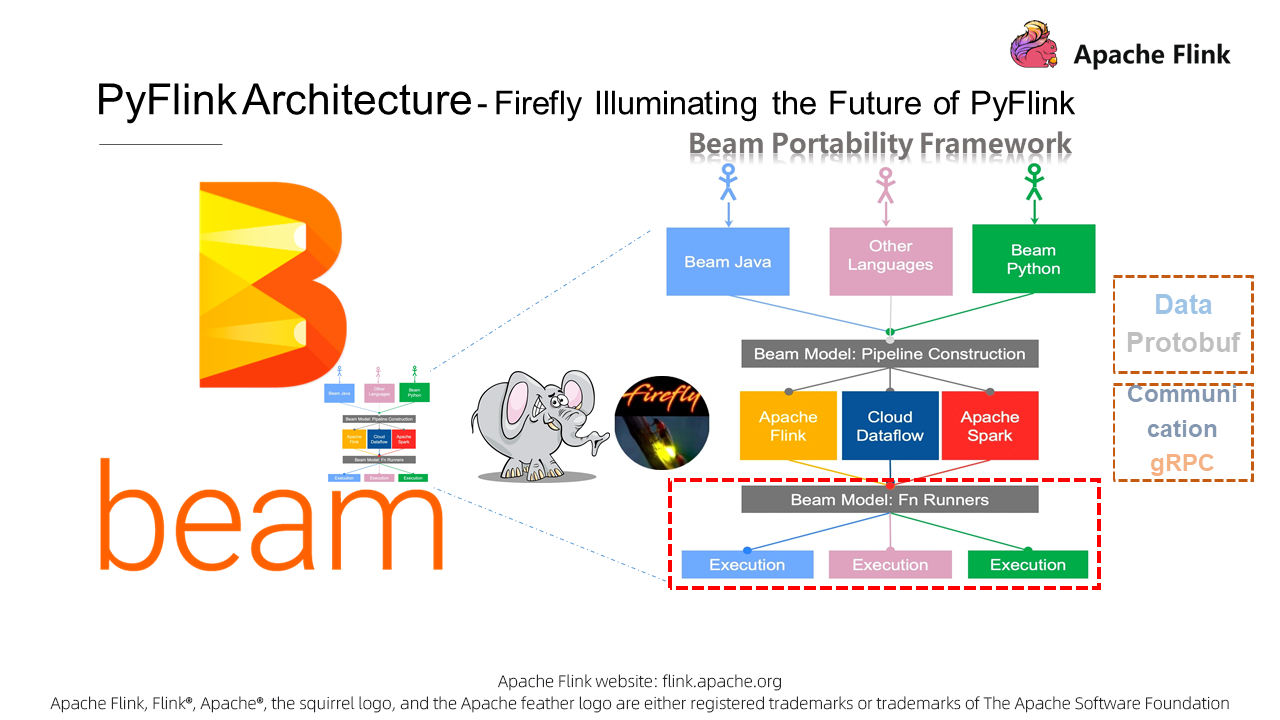
In the figure below, a runner represent a Flink Java operator. Runners map to SDK workers in the Python execution environment. Apache Beam has abstracted services such as Control, Data, State, and Logging. In fact, these services have been running stably and efficiently on Beam Flink runners for a long time. This makes PyFlink UDF execution easier. In addition, Apache Beam has solutions for both API calls and user-defined function execution. PyFlink uses Py4J for communications between virtual machines at the API level, and uses Apache Beam's Portability Framework for setting up the user-defined function execution environment.
This shows that PyFlink strictly follows the principle of achieving given objectives at minimal costs in technology selection, and always adopts the technical architecture that best suits long-term development. By the way, during cooperation with Apache Beam, I have submitted more than 20 optimization patches to the Beam community.
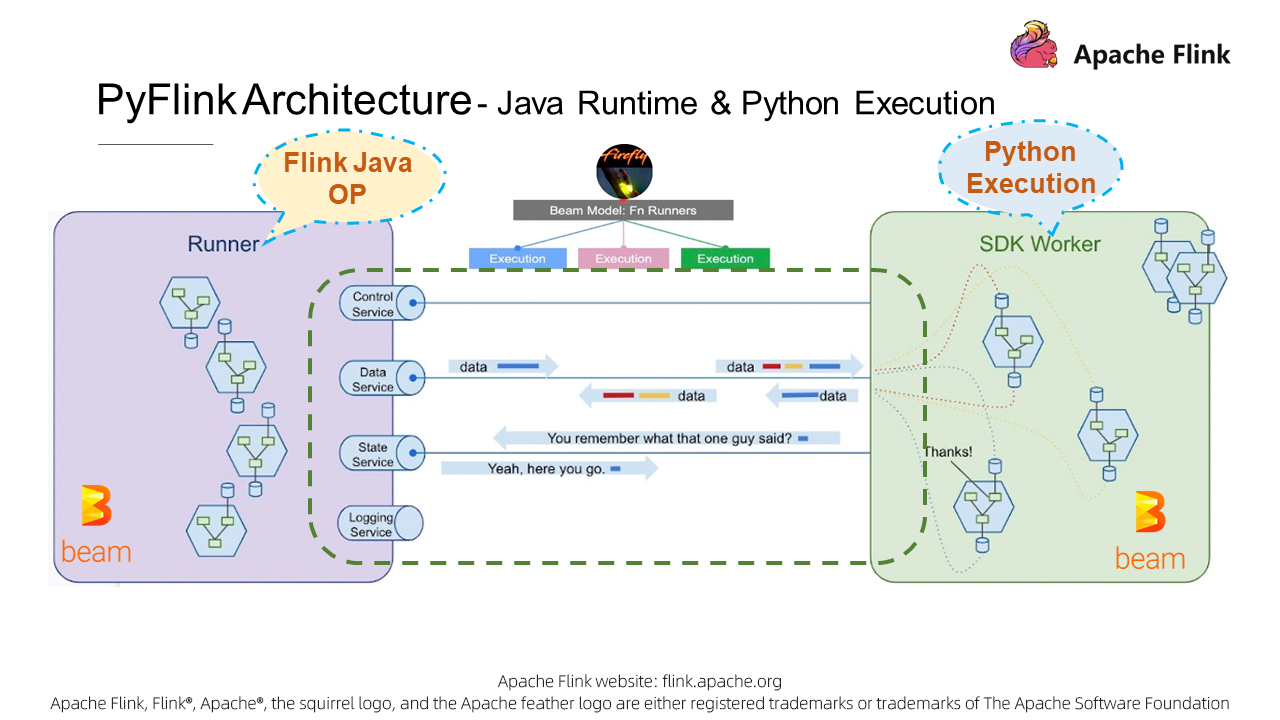
User-Defined Function Architecture
The UDF architecture needs to not only implement communication between PyVM and JVM, but also meet different requirements in the compilation and running stages. In the following PyLink user-defined function architecture diagram, behavior in JVM is indicated in green, and that in PyVM is indicated in blue. Let's look at the local design during compilation. The local design relies on pure API mapping calls. Py4J is used for VM communication. Each time we call a Python API, the corresponding Java API is called synchronously, as shown in the following GIF.
To support user-defined functions, a user-defined function registration API (register_function ) is required. When defining Python user-defined functions, you also need some third-party libraries. Therefore, a series of add methods such as add_Python_file() are required for adding dependencies. When you write a Python job, the Java API will also be called to create a JobGraph before you submit the job. Then you can submit the job to the cluster through several different methods like through a CLI.

Now let's look at how the Python API and Java API work in this architecture. On the Java side, JobMaster assigns jobs to TaskManager like it does with common Java jobs, and TaskManager executes tasks, which involve operator execution in both JVM and PyVM. In Python user-defined function operators, we will design various gRPC services for communication between JVM and PyVM; for example, DataService for business data communication, and StateService for Python UDFs to call Java State backends. Many other services such as Logging and Metrics will also be provided.
These services are built based on Beam's Fn APIs. User-defined functions are eventually run in Python workers, and the corresponding gRPC services return the results to Python user-defined function operators in JVM. Python workers can run as processes, in Docker containers, and even in external service clusters. This extension mechanism lays a solid foundation for the integration of PyFlink with other Python frameworks, which we will discuss later in PyFlink roadmap. Now that we have a basic understanding of the Python user-defined function architecture introduced in PyFlink 1.10, let's take a look at its benefits:
First, it is a mature multi-language support framework. The Beam-based architecture can be extended easily to support other languages. Second, support for stateful user-defined functions. Beam abstracts stateful services, which makes it easier for PyFlink to support stateful user-defined functions. Third, easy maintenance. Two active communities - Apache Beam and Apache Flink - maintain and optimize the same framework.
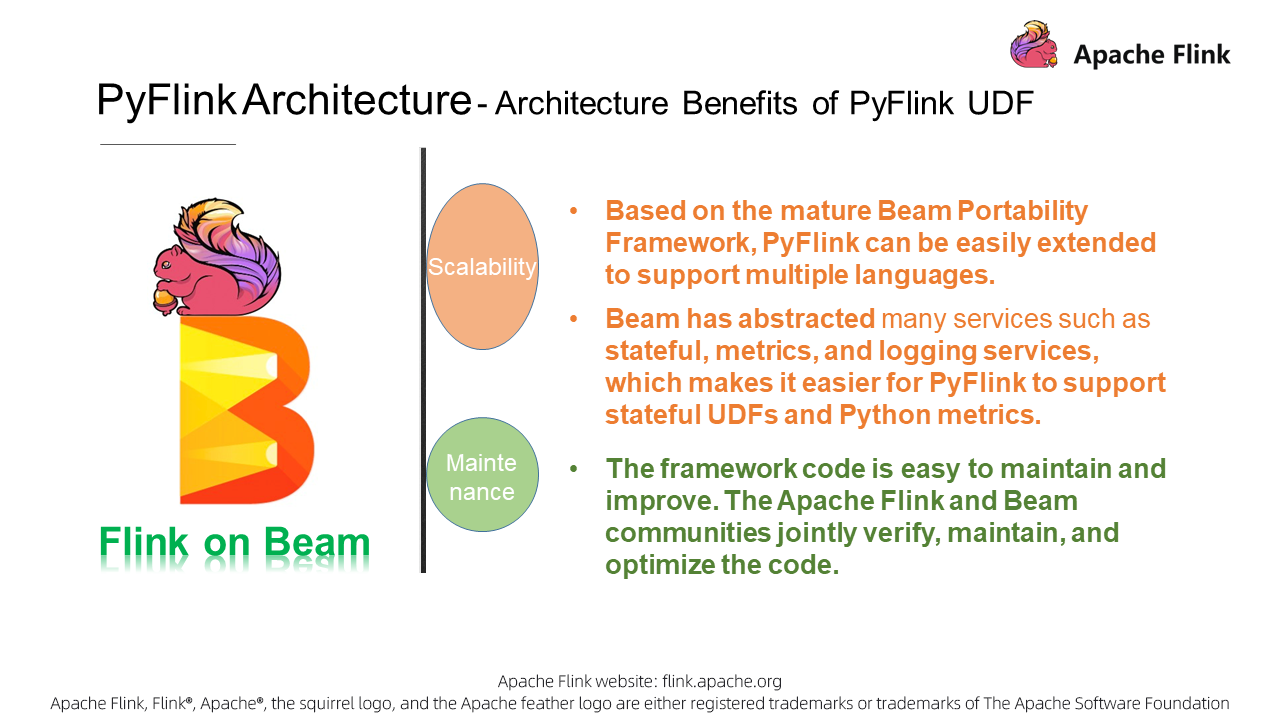
With the knowledge of PyFlink's architecture and the ideas behind it, let's look at specific application scenarios of PyFlink for a better understanding of the hows and whys behind it.
PyFlink's Application Scenarios
What are the business scenarios that PyFlink supports? We can analyze its application scenarios from two perspectives: Python and Java. Bear in mind that PyFlink is suitable for all scenarios where Java can apply, too.
You can use PyFlink in all these scenarios. PyFlink also applies to Python-specific scenarios, such as scientific computing. With so many application scenarios, you may wonder what specific PyFlink APIs are available for use now. So let's take a look into that question now, too.
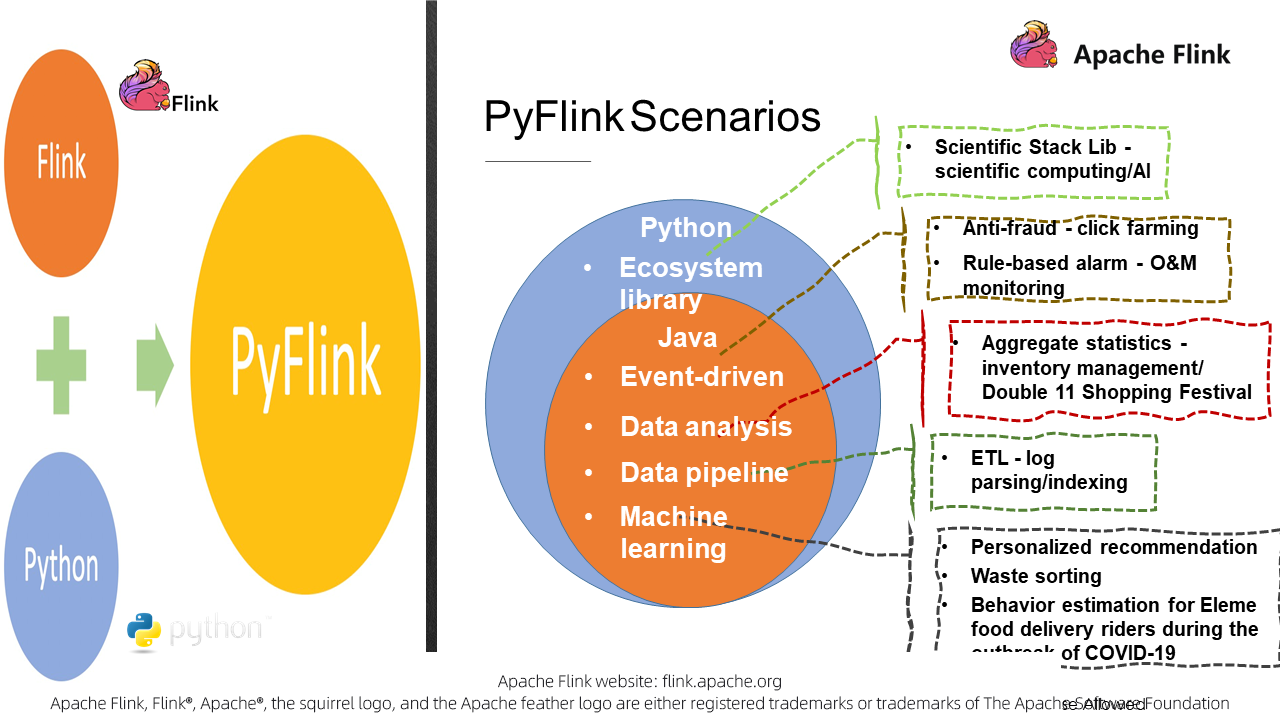
PyFlink Installation
Before using any API, you need to install PyFlink. Currently, to install PyFlink, run the command: `
pip install apache-Flink` .
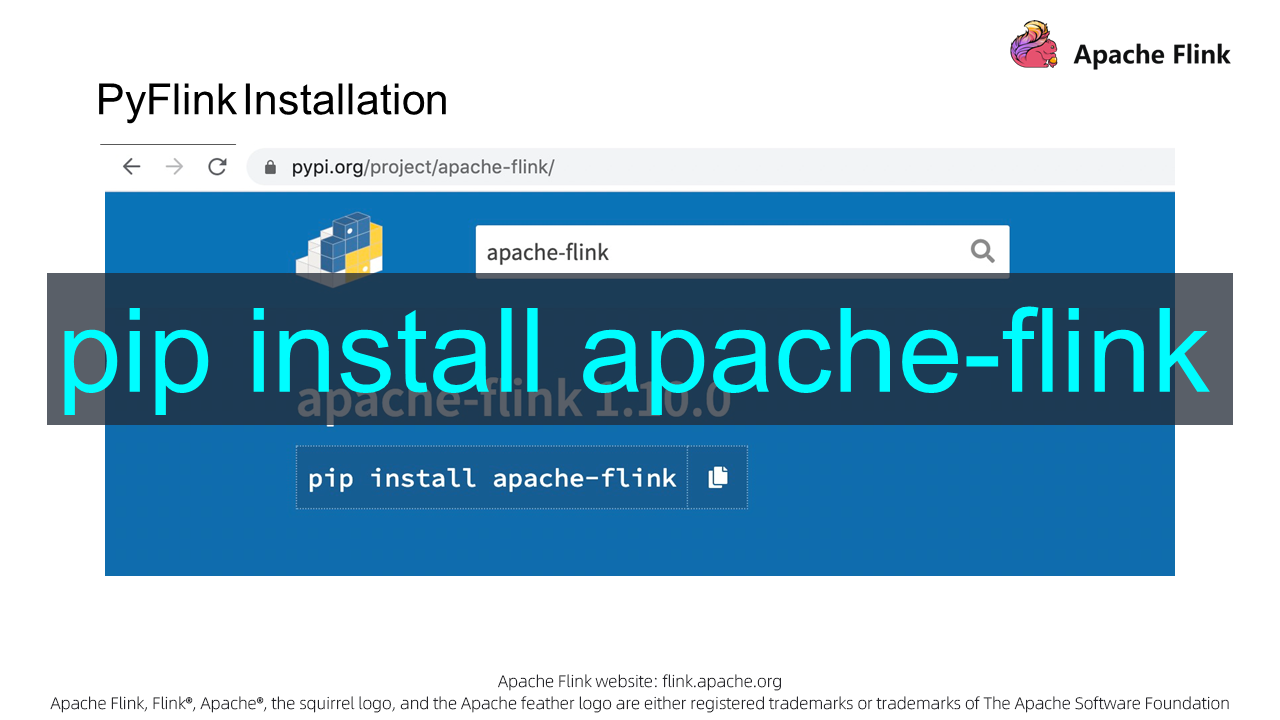
PyFlink APIs
PyFlink APIs are fully aligned with Java Table APIs to support various relational and window operations. Some ease-of-use PyFlink APIs are even more powerful than SQL APIs, such as APIs specific to column operations. In addition to APIs, PyFlink also provides multiple ways to define Python UDFs.
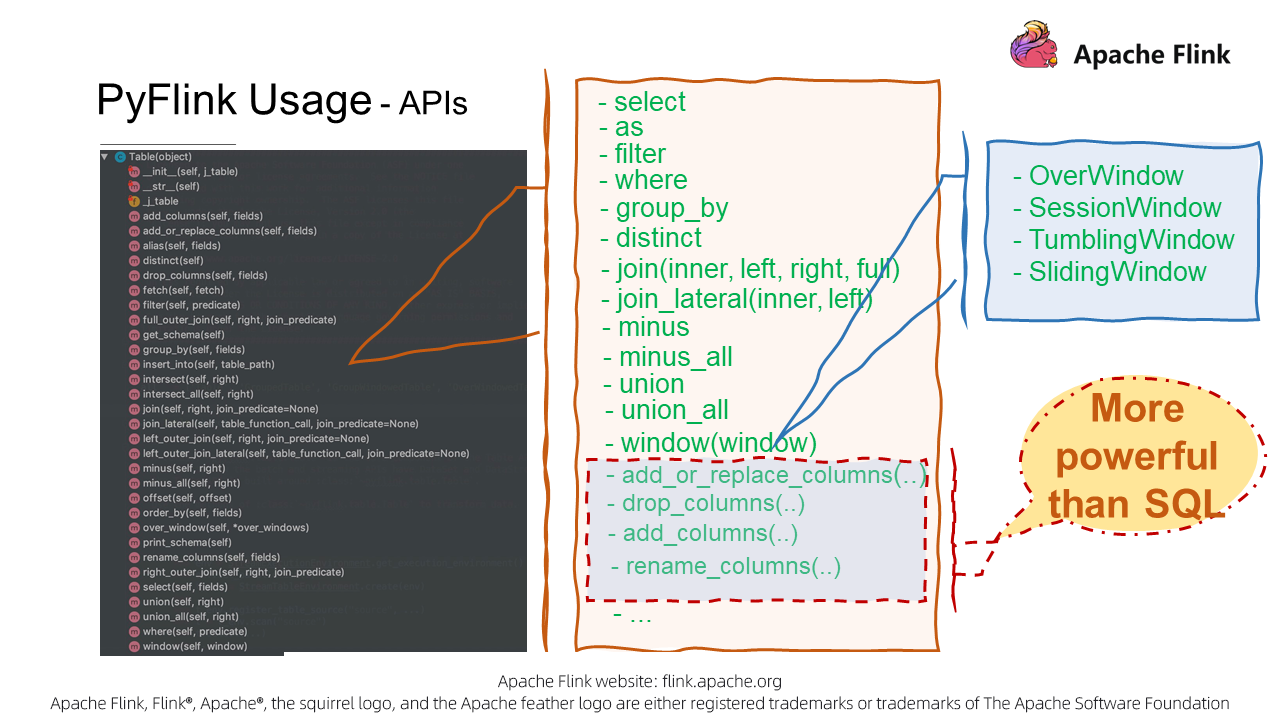
User-Defined Functions Definition in PyFlink
ScalarFunction can be extended (for example, by adding metrics) to provide more auxiliary features. In addition, PyFlink user-function functionss support all method definitions that Python supports, such as the lambda, named, and callable functions.
After defining these methods, we can use PyFlink Decorators for tagging, and describe the input and output data types. We can also further streamline later versions based on the type hint feature of Python, for type derivation. The following example will help you better understand how to define a user-defined function.
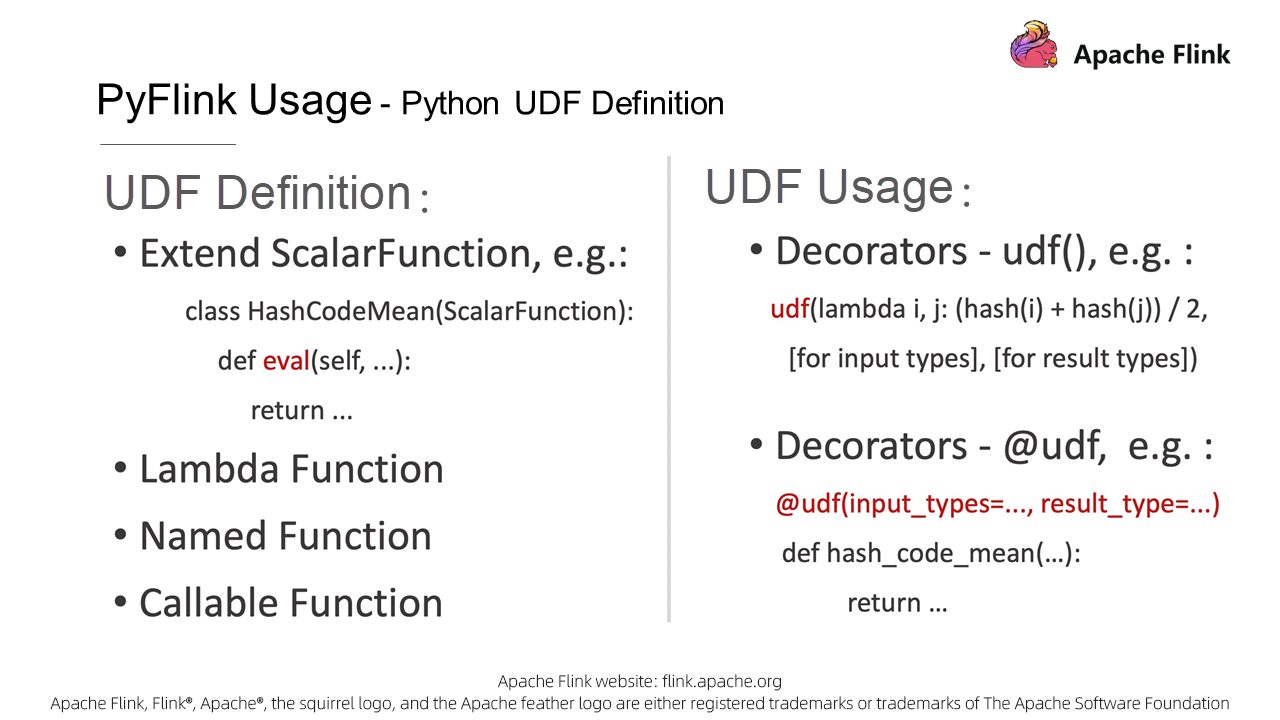
One Case of Defining a Python User-Defined Function
In this example case, we add up two numbers. First, for this, import necessary classes, then define the previously mentioned functions. This is pretty straightforward, so let's proceed to a practical case.
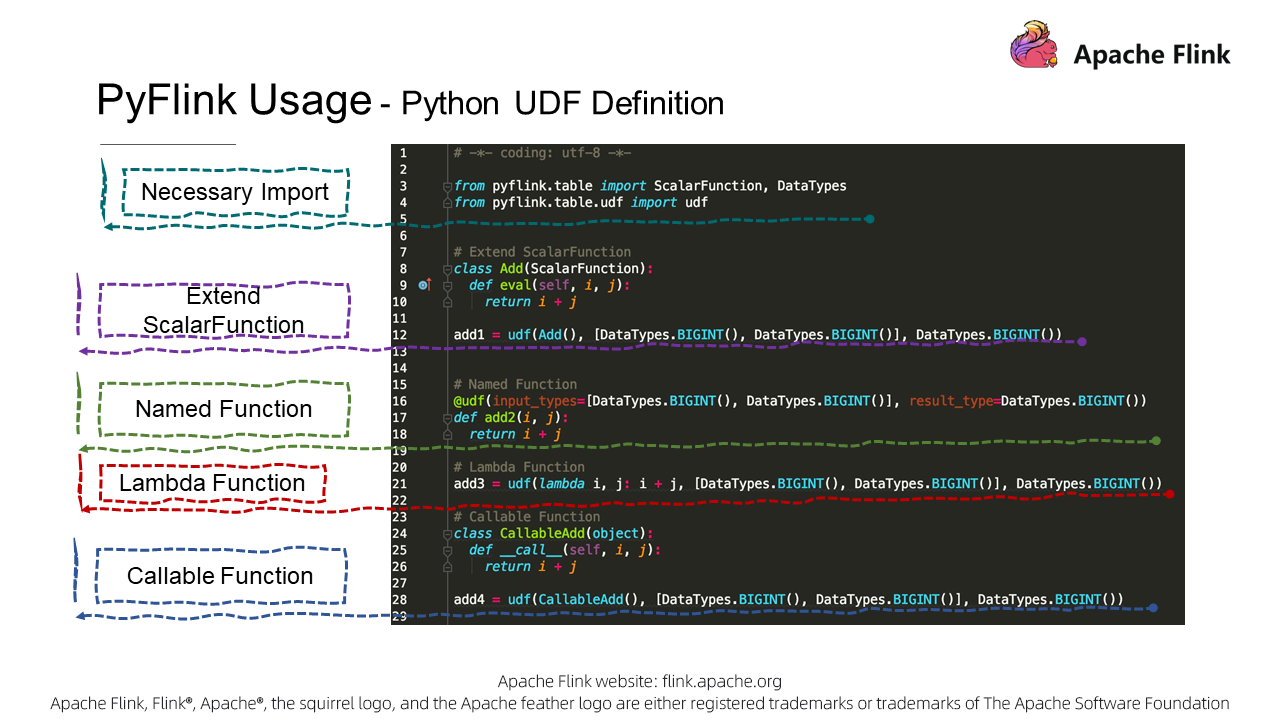
PyFlink Case: Real-time Log Analysis for Alibaba Cloud CDN
Here I take Alibaba Cloud Content Deliver Network (CDN)'s real-time log analysis feature as an example to show you how to use PyFlink to resolve practical business problems. Alibaba Cloud CDN is used to accelerate resource downloads. Generally, CDN logs are parsed in a common pattern: First, collect log data from edge nodes, and then save that data to message queues. Second, combine message queues and Realtime Compute clusters to perform real-time log analysis. Third, write analysis results into the storage system. In this example, the architecture is instantiated, Kafka is used as a message queue, Flink is used for real-time computing, and the final data is stored in a MySQL database.
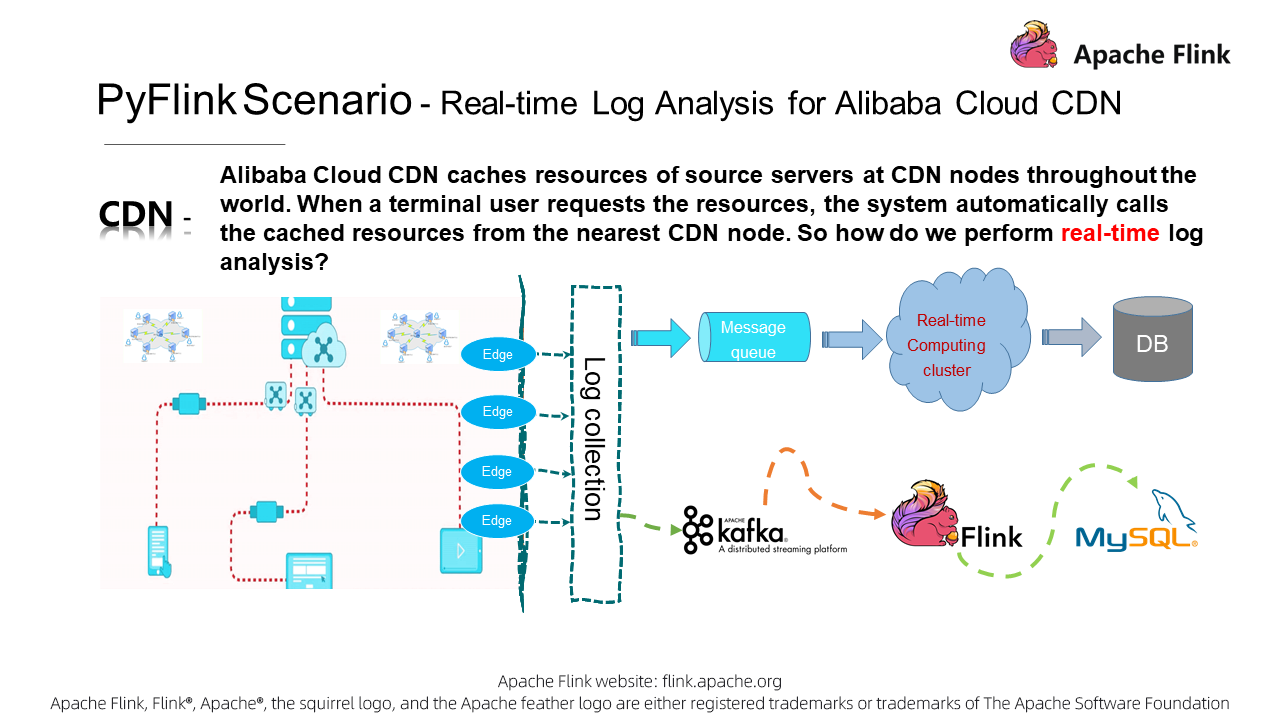
Requirements
For convenience, we have simplified the actual business statistical requirements. In this example, statistics for page views, downloads, and download speeds are collected by region. In terms of data formats, we have selected only core fields. For example, uuid indicates a unique log ID, client_ip indicates the access source, request_time indicates the resource download duration, and response_size indicates the resource data size. Here, the original logs do not contain a region field despite the requirement to collect statistics by region. Therefore, we need to define a Python UDF to query the region of each data point according to the client_ip . Let's analyze how to define the user-defined function.
User-Defined Function Definition
Here, the ip_to_province() user-defined function, a name function, is defined. The input is an IP address, and the output is a region name string. Here, both the input type and output type are defined as strings. The query service here is for demonstration purposes only. You'll need to replace it with a reliable region query service in your production environment.
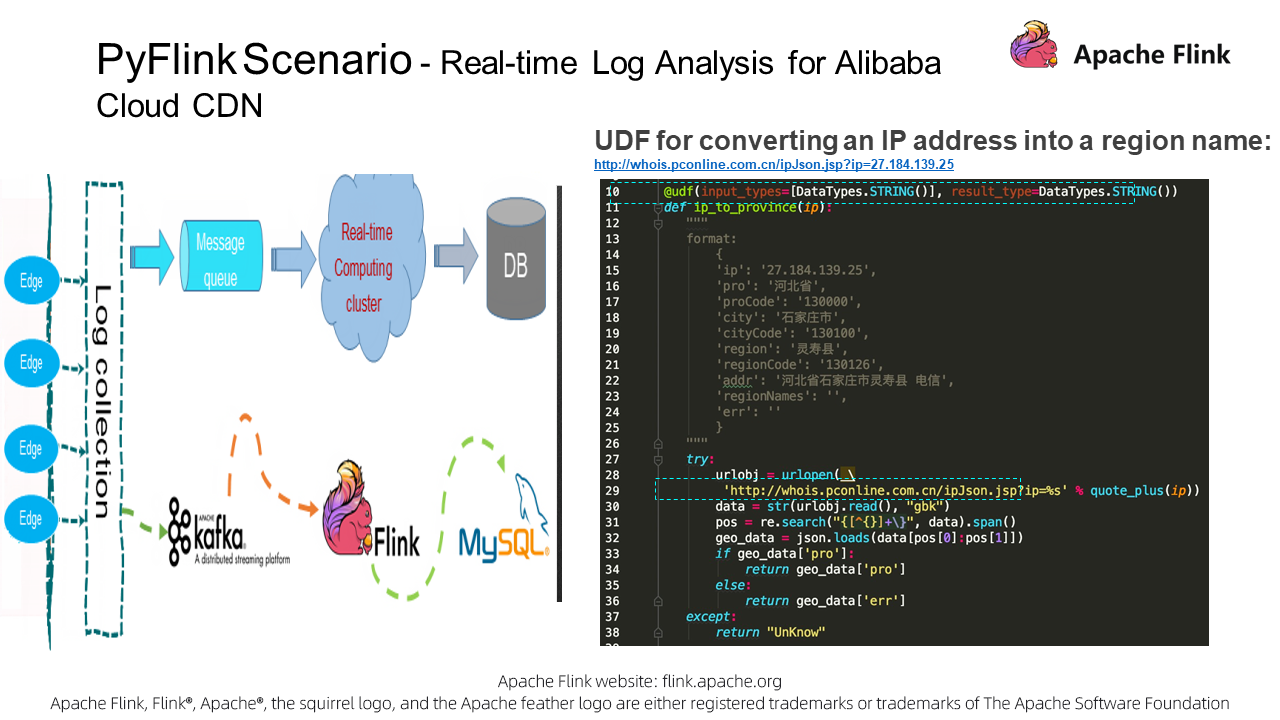
import re
import json
from pyFlink.table import DataTypes
from pyFlink.table.udf import udf
from urllib.parse import quote_plus
from urllib.request import urlopen
@udf(input_types=[DataTypes.STRING()], result_type=DataTypes.STRING())
def ip_to_province(ip):
"""
format:
{
'ip': '27.184.139.25',
'pro': '河北省',
'proCode': '130000',
'city': '石家庄市',
'cityCode': '130100',
'region': '灵寿县',
'regionCode': '130126',
'addr': '河北省石家庄市灵寿县 电信',
'regionNames': '',
'err': ''
}
"""
try:
urlobj = urlopen( \
'http://whois.pconline.com.cn/ipJson.jsp?ip=%s' % quote_plus(ip))
data = str(urlobj.read(), "gbk")
pos = re.search("{[^{}]+\}", data).span()
geo_data = json.loads(data[pos[0]:pos[1]])
if geo_data['pro']:
return geo_data['pro']
else:
return geo_data['err']
except:
return "UnKnow"Connector Definition
So far, we have analyzed the requirements and defined the user-defined function, so now let's proceed to job development. According to the general job structure, we need to define a Source connector to read Kafka data, and a Sink connector to store the computing results to a MySQL database. Last, we also need to write the statistical logic.
Note that PyFlink also supports SQL DDL statements, and we can use a simple DDL statement to define the Source connector. Be sure to set connector.type to Kafka. You can also use a DDL statement to define the Sink connector, and set connector.type to jdbc. As you can see, the logic of connector definition is quite simple. Next, let's take a look at the core statistical logic.

kafka_source_ddl = """
CREATE TABLE cdn_access_log (
uuid VARCHAR,
client_ip VARCHAR,
request_time BIGINT,
response_size BIGINT,
uri VARCHAR
) WITH (
'connector.type' = 'kafka',
'connector.version' = 'universal',
'connector.topic' = 'access_log',
'connector.properties.zookeeper.connect' = 'localhost:2181',
'connector.properties.bootstrap.servers' = 'localhost:9092',
'format.type' = 'csv',
'format.ignore-parse-errors' = 'true'
)
"""
mysql_sink_ddl = """
CREATE TABLE cdn_access_statistic (
province VARCHAR,
access_count BIGINT,
total_download BIGINT,
download_speed DOUBLE
) WITH (
'connector.type' = 'jdbc',
'connector.url' = 'jdbc:mysql://localhost:3306/Flink',
'connector.table' = 'access_statistic',
'connector.username' = 'root',
'connector.password' = 'root',
'connector.write.flush.interval' = '1s'
)
"""Core Statistical Logic
For this part, you'll need to first read data from the data source, and then convert the client_ip into a specific region through ip_to_province(ip). Second, collect statistics for page views, downloads, and download speeds by region. Last, store the statistical results are in the result table. In this statistical logic, we not only use the Python user-defined function, but also two built-in Java AGG functions of Flink: sum and count.
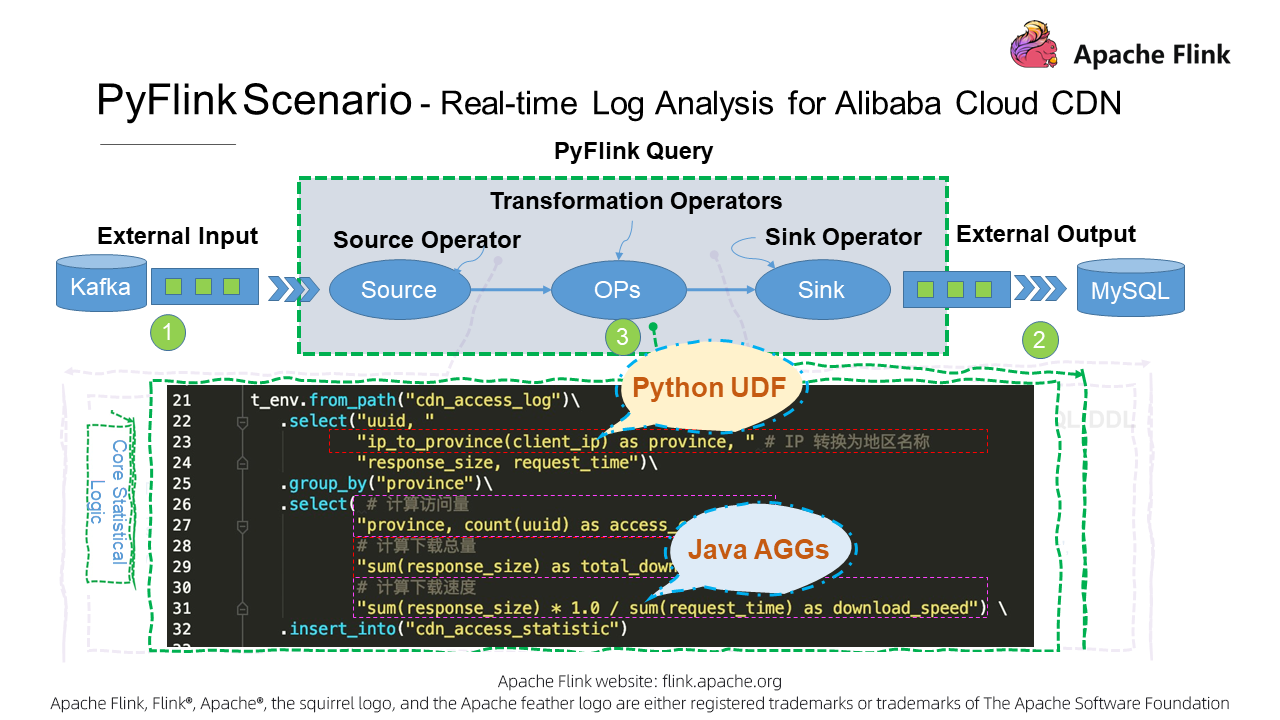
# 核心的统计逻辑
t_env.from_path("cdn_access_log")\
.select("uuid, "
"ip_to_province(client_ip) as province, " # IP 转换为地区名称
"response_size, request_time")\
.group_by("province")\
.select( # 计算访问量
"province, count(uuid) as access_count, "
# 计算下载总量
"sum(response_size) as total_download, "
# 计算下载速度
"sum(response_size) * 1.0 / sum(request_time) as download_speed") \
.insert_into("cdn_access_statistic")Complete Code for Real-time Log Analysis
Now let's go through the code again. First, you'll need to import core dependencies, then create an ENV, and last set a planner. Currently, Flink supports Flink and Blink planners. We recommend that you use the Blink planner.
Second, run DDL statements to register the Kafka source table and MySQL result table that we defined earlier. Third, register the Python UDF. Note that you can specify other dependency files of the UDF in the API request, and then submit them to the cluster together with the job. Finally, write the core statistical logic, and call the executor to submit the job. So far, we have created an Alibaba Cloud CDN real-time log analysis job. Now, let's check the actual statistical results.
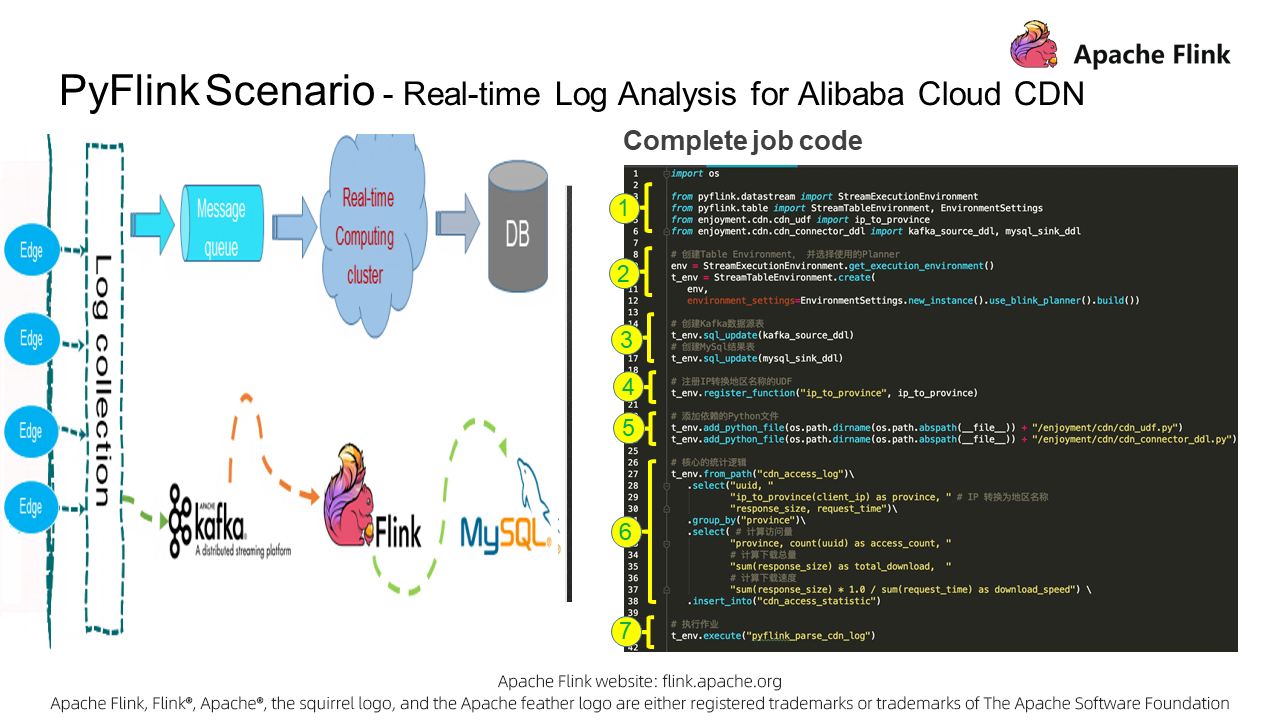
import os
from pyFlink.datastream import StreamExecutionEnvironment
from pyFlink.table import StreamTableEnvironment, EnvironmentSettings
from enjoyment.cdn.cdn_udf import ip_to_province
from enjoyment.cdn.cdn_connector_ddl import kafka_source_ddl, mysql_sink_ddl
# 创建Table Environment, 并选择使用的Planner
env = StreamExecutionEnvironment.get_execution_environment()
t_env = StreamTableEnvironment.create(
env,
environment_settings=EnvironmentSettings.new_instance().use_blink_planner().build())
# 创建Kafka数据源表
t_env.sql_update(kafka_source_ddl)
# 创建MySql结果表
t_env.sql_update(mysql_sink_ddl)
# 注册IP转换地区名称的UDF
t_env.register_function("ip_to_province", ip_to_province)
# 添加依赖的Python文件
t_env.add_Python_file(
os.path.dirname(os.path.abspath(__file__)) + "/enjoyment/cdn/cdn_udf.py")
t_env.add_Python_file(os.path.dirname(
os.path.abspath(__file__)) + "/enjoyment/cdn/cdn_connector_ddl.py")
# 核心的统计逻辑
t_env.from_path("cdn_access_log")\
.select("uuid, "
"ip_to_province(client_ip) as province, " # IP 转换为地区名称
"response_size, request_time")\
.group_by("province")\
.select( # 计算访问量
"province, count(uuid) as access_count, "
# 计算下载总量
"sum(response_size) as total_download, "
# 计算下载速度
"sum(response_size) * 1.0 / sum(request_time) as download_speed") \
.insert_into("cdn_access_statistic")
# 执行作业
t_env.execute("pyFlink_parse_cdn_log")
Output Results for Real-time Log Analysis
We sent mock data to Kafka as CDN log data. On the right side of the figure below, statistics for page views, downloads, and download speed are collected by region in real time.
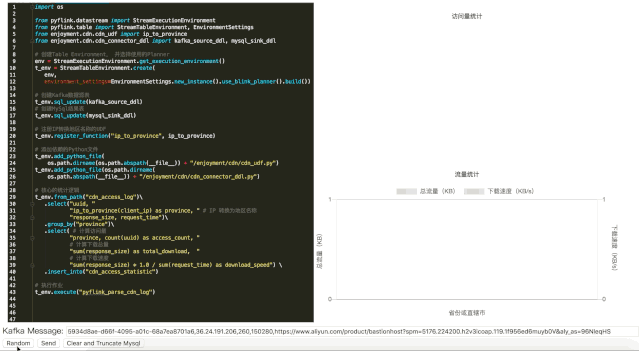
One of the release managers of Flink 1.11.0 shares his deep insights into the long-awaited features and explains them from different perspectives.
Flink 1.11.0 was officially released after four candidate versions were published following the "freeze time" feature. A total of 236 contributors participated in the development of the 1.11.0 version, and they submitted 2,325 commits. This version fixed 1,474 JIRA issues and involved more than 30 Flink Improvement Proposals (FLIPs.)
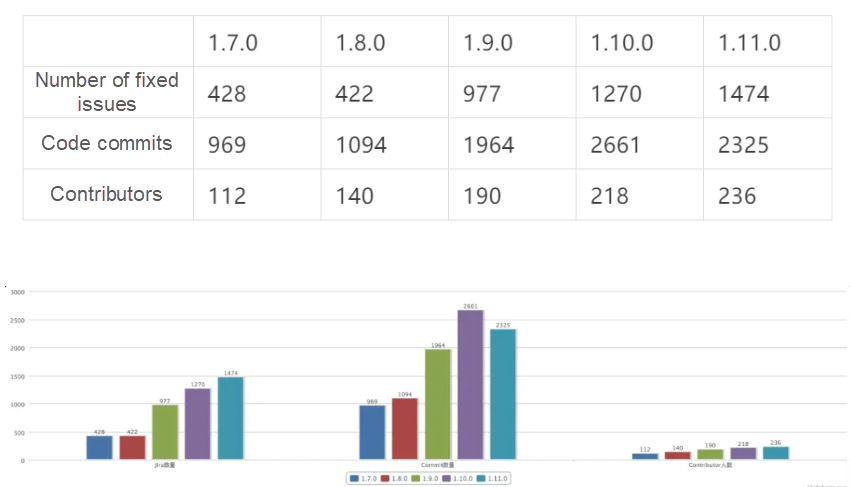
Five Flink versions have been released so far. Since version 1.9.0, Flink has seen rapid development, with its performance metrics nearly doubling compared with earlier versions. The proprietary Blink project of Alibaba was fully integrated with Apache Flink starting from 1.9.0 until 1.10.0. This significantly improved the ecosystem construction, functionality, performance, and production availability of Flink.
Flink 1.11.0 was initially designed to make Flink easier to use and improve user experience in business production. It does not involve major architecture adjustments or feature development. This version was a minor update that was developed through fast iteration. However, according to the preceding statistics, the performance metrics of Flink 1.11.0 are comparable to those of 1.9.0 and 1.10.0. The number of issues fixed and participating contributors have been increasing since the first Flink version was released. The proportion of Chinese contributors reached 62% for Flink 1.11.0.
This blog explains the long-awaited features of Flink 1.11.0 from different perspectives, especially the features related to out-of-the-box APIs and the execution engine. For a complete list of features, see the Flink release blog.
You can use content delivery network (CDN) to deliver content to users from the nodes that are nearest to them, accelerating the response to user requests and increasing the response rate. CDN also resolves the delivery latency problem that is usually caused by distribution, bandwidth, and server performance issues. CDN has been applied in multiple scenarios, including site acceleration, on-demand streaming, and live streaming.
Realtime Compute for Apache Flink offers a highly integrated platform for real-time data processing, which optimizes the computing of Apache Flink. With Realtime Compute, we are striving to deliver new solutions to help you upgrade your big data capabilities in your digital transformations.
This topic describes the architecture of Realtime Compute for Apache Flink in exclusive mode.
Realtime Compute for Apache Flink is widely used for real-time big data computing. This topic describes how to apply Realtime Compute for Apache Flink to different enterprise departments and technologies.
A New Milestone for Alibaba Cloud's Container and Serverless Services

2,599 posts | 765 followers
FollowApache Flink Community China - April 23, 2020
Apache Flink Community China - September 29, 2021
Apache Flink Community China - August 11, 2021
Data Geek - May 9, 2023
Apache Flink Community China - August 22, 2023
Apache Flink Community China - November 6, 2020

2,599 posts | 765 followers
Follow CDN(Alibaba Cloud CDN)
CDN(Alibaba Cloud CDN)
A scalable and high-performance content delivery service for accelerated distribution of content to users across the globe
Learn More Realtime Compute for Apache Flink
Realtime Compute for Apache Flink
Realtime Compute for Apache Flink offers a highly integrated platform for real-time data processing, which optimizes the computing of Apache Flink.
Learn MoreMore Posts by Alibaba Clouder
Start building with 50+ products and up to 12 months usage for Elastic Compute Service
Get Started for Free Get Started for Free